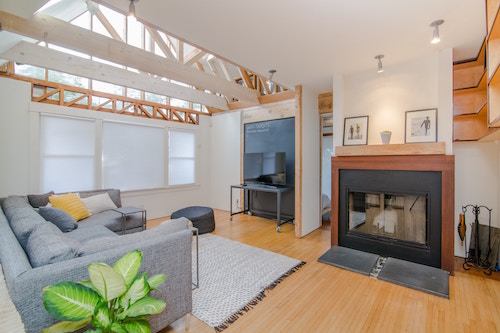 There is more to lighting than meets the eye. An integral part of our health and wellbeing, light affects our bodies physiology and can have major impacts on our daily routines and rhythms. Fortunately there are ways to use and organise light in your home to make use of the good impacts of light and mitigate the negative effects.
There is more to lighting than meets the eye. An integral part of our health and wellbeing, light affects our bodies physiology and can have major impacts on our daily routines and rhythms. Fortunately there are ways to use and organise light in your home to make use of the good impacts of light and mitigate the negative effects.
Poor lighting
Poor lighting brings a whole host of health challenges such as increased risk of injury, certain types of sight loss, skin conditions, depressive symptoms, glare, eyestrain and headaches. In a poorly lit environment our eyes need to work extra hard to focus and see and this can result in eyestrain and headaches. Inconsistent or faulting lights that flash on and off can cause headaches, nausea, dizziness and even epileptic seizures. Poorly lit areas increase risk of injury by tripping, slipping or falling. This is an especially important factor in the homes of older people as there are changes that occur in the eye as we age which mean that someone who is 75 years old would need nearly four times as light as a 20 year old would, in order to see satisfactorily. With this in mind, ensuring there is adequate lighting in all main walkways with particular focus on stairs, uneven areas or changes in flooring type such as from a carpeted area to a tiled one. Consistent poor lighting and lack of sunlight can cause depressive symptoms known as ‘Seasonal Affective Disorder’ (SAD), sometimes called the “winter blues” as reduced natural light hours during winter sometimes result an increase in cases of the illness.
Overlighting
Just as Poor lighting can cause health problems so too can too much light. We all remember as children being told not to look directly into the sun or not to shine toy laser lights into friends eyes. This is an obvious risk of direct eye damage from too much light but there are more subtle forms too such as headaches, damage to vision and eyestrain from squinting to minimise bright lights and glare. If you are sensitive to bright lights it is important to invest in a quality pair of sunglasses that wrap around to give full eye protection from the sun when outdoors. To reduce the impact of glare in the home you can instal dimmers on your lights, opt for matte finishes over highly reflective gloss and rearrange monitors such as tvs and computers so that reflections from light sources do not interfere with viewing. Being in artificial brightly lit areas particularly after the sun has gone down causes a whole range of issues due to the disruption of the circadian rhythm.
Timing of lighting
Perhaps the number one most important health consideration of light is when and for how long we experience light and dark. The timing of light affects our internal timing, our body clock, this is known as the circadian rhythm. Our internal body clock takes its cue from light and signals when to turn on and off hormones that control body processes such as when to sleep and wake. With the advent of artificial lighting we no longer experience light the way our bodies used to. We do not always wake with the natural morning light and very few of us go to sleep as the sun sets. Darkness triggers the human body to produce a hormone called melatonin which makes us sleepy and light triggers a hormone cortisol which makes us alert and awake. When our Circadian Rhythm is properly synced, we sleep well throughout the night and wake early in the morning, maintaining energy throughout the day. But staying in well lit areas or looking at tvs, computer, tablet and phone screens means we tend to stay up a lot later and also delays the release of melatonin which disrupts our ability to get a good night's sleep. This means we are too tired to wake when we should in the morning. The outcomes that can be produced from long term disruptions to circadian rhythms such as is experienced by shift workers, frequent international fliers and astronauts can be very severe. Long term body clock disruptions have been linked to illnesses including diabetes, obesity and depression. Dimming the lights in your home in the evenings, turning down the brightness of digital screens or using night-time/blue light filtering settings and leaving your curtains open to allow the daylight to wake you up are all great tips to help you maintain a healthy circadian rhythm.
Types of lighting
We have discussed before the differences in the colour temperature of light, usually categorised in the cooler bluish white lights to warmer yellow tones. Often these differences are talked about in terms of styling, atmosphere and appearance of the light but these differences also impact our circadian rhythm and therefore our health. Researchers have discovered that lights with more of a blue tone are more likely to make you feel awake and alert because it is most similar to bright early morning light and therefore likely triggers ‘time to wake up and be active’ hormones. We can hack these discoveries to maximise our productivity and health by using cooler blue toned lights during the day and in task focussed areas such as the office or a home study lamp to help increase productivity and stay alert. Then we we begin winding down for the evening switch off all sources of blue light and change to dimmed lights or a warmer tone. There are many useful tools to help with this including dimmer switches, colour changing LEDs such as this one, night time settings on digital screens and even blue light filtering eye glasses.
Final tips
- Experience natural daylight as much as possible particularly early in the morning.
- Avoid blue toned light in the evenings and opt for low level lighting in warmer tones.
- Utilise blue toned light throughout the day or when you need to be awake, alert and focussed.
- Ensure you have adequate lighting, especially as you age. Focus on task orientated areas and high traffic or higher risk areas such as stairways.
- Invest in a quality pair of sunglasses that wrap around to give full eye protection from the sun when outdoors.
- Install dimmer switches on all your household lights and use colour changing LEDs so that you can switch from cool to warm tones throughout the day.


